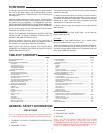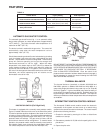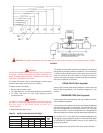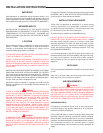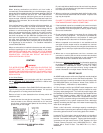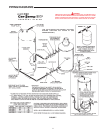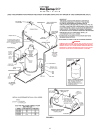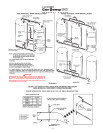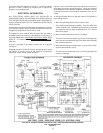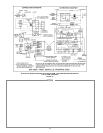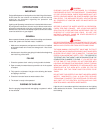
10
Your local code authority may have other specific relief valve
requirements not covered in this section.
THE PURPOSE OF A RELIEF VALVE IS TO AVOID EXCESSIVE
PRESSURE OR TEMPERATURE INTO THE STEAM RANGE,
WHICH MAY CAUSE SCALDING AT FIXTURES, TANK
EXPLOSION, SYSTEM OR HEATER DAMAGE.
TO AVOID SCALDING OR WATER DAMAGE, A DRAIN LINE
MUST BE CONNECTED TO A RELIEF VALVE TO DIRECT
DISCHARGE TO A SAFE LOCATION. A DRAIN LINE MUST
NOT BE REDUCED FROM THE SIZE OF THE VALVE OUTLET
AND IT MUST NOT CONTAIN ANY VALVES BETWEEN THE
HEATER AND THE RELIEF VALVE OR THE RELIEF VALVE AND
THE DRAIN LINE EXIT. IN ADDITION, THERE SHOULD NOT
BE ANY RESTRICTIONS IN A DRAIN LINE NOR SHOULD IT
BE ROUTED THROUGH AREAS WHERE FREEZING
CONDITIONS MIGHT OCCUR. DO NOT THREAD OR CAP THE
DRAIN LINE EXIT. RESTRICTING OR BLOCKING A DRAIN
LINE WILL DEFEAT THE PURPOSE OF THE RELIEF VALVE
AND MAY CREATE AN UNSAFE CONDITION. INSTALL A
DRAIN LINE WITH A DOWNWARD SLOPE SUCH THAT IT
NATURALLY DRAINS ITSELF.
Recommended locations of relief valves are shown in the
installation diagrams.
HARD WATER
Where hard water conditions exist, water softening or the threshold
type of water treatment is recommended. This will protect the
dishwashers, coffee urns, water heaters, water piping and other
equipment. When water softening or water treatment is not
practical, a comparatively easy method of periodic lime removal
from the heater may be employed by installing gate valves, drain
valve and acid fill opening as shown in PREVENTIVE
MAINTENANCE section of this manual.
CLOSED WATER SYSTEM
A closed system will exist if a back-flow prevention device (check
valve), pressure reducing valve, or other similar device is installed
in the cold water line between the water heater and the street
main (or well). Excessive pressure may develop due to the
thermal expansion of heated water causing premature tank
failure or intermittent relief valve operation. This is not a warranty
failure. An expansion tank may be necessary in the cold water
supply to alleviate this situation. Contact the local plumbing
authority.
WATER LINE CONNECTIONS
This manual provides detailed installation diagrams for typical
methods of application. See piping diagrams.
• Cer-Temp 80 Recovery System (for one temperature water).
These diagrams will serve to provide the installer with a reference
for the materials and method of piping necessary for installation.
It is essential that all water and gas piping, vent connections,
electrical wiring and check and flow regulating valves be installed
as shown on the diagrams.
Consult the installation diagrams for appropriate locations to
install the safety flow switch(es), drain valves, thermometers,
relief valves and the circulating pump(s). Apply suitable pipe
thread sealing compounds to only the male threads of parts to
be connected. If any of these parts are being replaced in a
functioning system, remember to shut off the manual gas and
control valve(s) and close off the water inlet(s). Open a nearby
faucet to relieve pressure and drain the heater and/or system
before attempting to install the new parts.
Check the diagrams thoroughly before starting installation to
avoid errors and minimize time and material costs.
If the system is to be filled with water for testing or other
purposes during cold weather and before actual operation, care
must be taken to prevent a downdraft entering the heater or
freezing air from contacting the system. Failure to do so may
cause the water in the system to freeze with resulting damage
to the system. Damage due to freezing is not covered by the
warranty.
WATER (POTABLE) HEATING
1. All piping components connected to this unit for space
heating applications shall be suitable for use with potable
water.
2. Toxic chemicals, such as those used for boiler treatment,
shall NEVER be introduced into this system.
3. This unit may NEVER be connected to any existing heating
system or component(s) previously used with a non-potable
water heating appliance.




